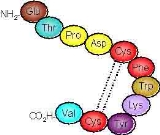
Urotensin-II
Encyclopedia
Urotensin-II is a peptide ligand, initially isolated from the neurosecretory system of the Goby
fish (Gillichthys mirabilis). For many years it was thought that U-II does not exhibit significant effects in mammalian systems; a view quickly overturned when it was demonstrated that Goby U-II produces slow relaxation of mouse annococygeus muscle, in addition to contraction of rat artery segments. In 1998, the cDNA encoding a U-II precursor was cloned in humans, unequivocally demonstrating its existence in mammalian species.
In fish, U-II is secreted at the back part of the spinal cord, in a neurosecretory center called uroneurapophysa, and is involved in the regulation of the renal and cardiovascular systems. In mammals, it is involved in the regulation of the cardiovascular system.
has acted to conserve this sequence, highlights its physiological importance, indeed this hexapeptide sequence confers biological activity
.
Goby
The gobies form the family Gobiidae, which is one of the largest families of fish, with more than 2,000 species in more than 200 genera. Most are relatively small, typically less than 10 cm in length...
fish (Gillichthys mirabilis). For many years it was thought that U-II does not exhibit significant effects in mammalian systems; a view quickly overturned when it was demonstrated that Goby U-II produces slow relaxation of mouse annococygeus muscle, in addition to contraction of rat artery segments. In 1998, the cDNA encoding a U-II precursor was cloned in humans, unequivocally demonstrating its existence in mammalian species.
In fish, U-II is secreted at the back part of the spinal cord, in a neurosecretory center called uroneurapophysa, and is involved in the regulation of the renal and cardiovascular systems. In mammals, it is involved in the regulation of the cardiovascular system.
U-II peptide
As with other peptide ligands, U-II is synthesised from a larger precursor molecule, known as Prepro-urotensin-II, two isoforms have been identified in man of lengths 124 and 139 residues. Cleavage of either of these precursors produces identical, eleven residue, mature U-II peptides. The cyclic, C-terminal hexapeptide sequence((-CYS*-TRY-LYS-TRP-PHE-CYS*-), (*bridged CYS residues)), has been conserved through evolution from lamprey to human, species which diverged some 560 million years ago. The fact that such a strong evolutionary pressureEvolutionary pressure
Any cause that reduces reproductive success in a proportion of a population, potentially exerts evolutionary pressure or selection pressure. With sufficient pressure, inherited traits that mitigate its effects - even if they would be deleterious in other circumstances - can become widely spread...
has acted to conserve this sequence, highlights its physiological importance, indeed this hexapeptide sequence confers biological activity
Biological activity
In pharmacology, biological activity or pharmacological activity describes the beneficial or adverse effects of a drug on living matter. When a drug is a complex chemical mixture, this activity is exerted by the substance's active ingredient or pharmacophore but can be modified by the other...
.

